A marine census has documented more than 13,000 species in the Arctic and Antarctic Oceans, including several hundred that may be new to science.
Conducted over a two-year period under often perilous conditions — including monster waves, freezing seas, and dangerous polar bears — the series of 18 surveys turned up a wealth of information on the diversity, distribution and abundance of marine life. The research will also help establish a baseline for measure changes in polar ecosystems.
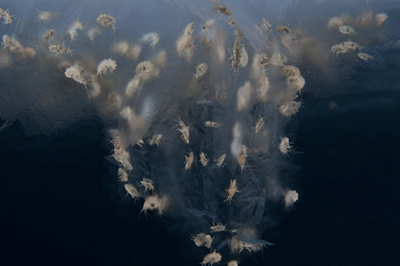 This is a photo of sand fleas (amphipod crustaceans) under nearshore ice in the Beaufort Sea. Ice-associated amphipods are a major food source for Arctic cod, in turn the main prey for ice seals. Credit: Photo credit: Shawn Harper, University of Alaska Fairbanks / COML |
“The polar seas, far from being biological deserts, teem with an amazing quantity and variety of life,” Dr. Ian Poiner, Chair of the Census Scientific Steering Committee for the Census of Marine Life (CoML), said. “Only through the co-operation of 500 people from more than 25 countries could the daunting environmental challenges be overcome to produce research of such unprecedented scale and importance. And humanity is only starting to understand the nature of these regions.”
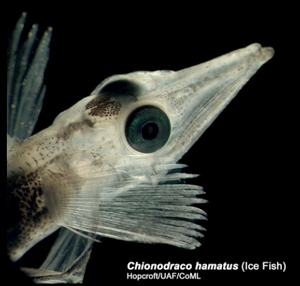 Chionodraco hamatus, an Antarctic ice fish, can withstand temperatures that freeze the blood of all other fish types. This finger-lengthed juvenile was photographed in 2008. 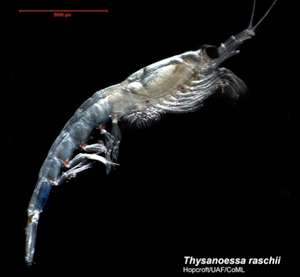 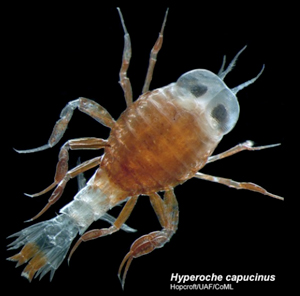 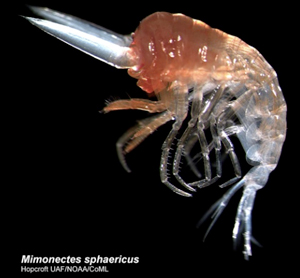 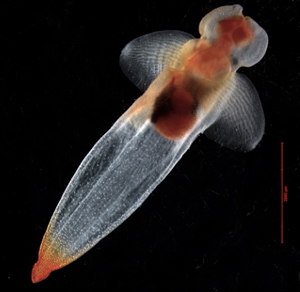 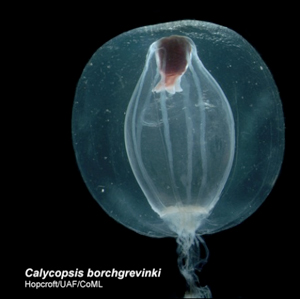 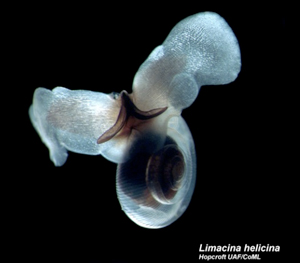 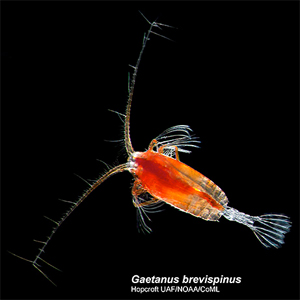 The tiny crustacean Gaetanus brevispinus is among 235 found to live in both Arctic and Antarctic waters. All photos courtesy Russ Hopcroft, University of Alaska Fairbanks, Census of Marine Life |
“In these unique oceans, where the water temperature is colder at the surface than below, we are establishing the first benchmarks of marine biodiversity against which change may be measured, a significant polar year legacy for future generations,” he continued. “The significant investment of nations, the skills of scientists from the many ocean research disciplines, and the social network of the Census of Marine Life made it happen.”
The surveys surprisingly turned up dozens of species found in both seas, despite a separation of 13,000 kilometers. Now the scientists have to determine how these species — including worms, crustaceans, and angelic snail-like pteropods — originated and how they ended up on both poles.
The researchers also studied sections of seafloor that have been exposed to sunlight for the first time in 100,000 years due to melting ice. They found an abundance of sea life. The researchers have now accumulated more nearly one million marine life observations from both the Arctic and the Antarctic in a pair of marine biodiversity databases.
“One hundred years ago, Antarctic explorers like Scott and Shackleton saw mostly ice,” said Victoria Wadley of the of the Australian Antarctic Division. “In 2009, we see life everywhere.”
“We have filled in major blank spots on the Arctic map, and continue to add more, though big unobserved areas remain,” added Russ Hopcroft of the University of Alaska.
To date the census has recorded 7,500 animal species in the Antarctic and 5,500 in the Arctic. Scientists estimate some 230,000-250,000 species live in the world’s oceans.
CoML has relied heavily on new technology for the surveys. Researchers are using cell phone-like devices to track marine mammals like narwhals and have employed deep water optical systems on Remotely Operated Vehicles (ROVs) to study delicate marine animals too fragile to collect as well as record video of penguins and seals under Antarctic ice. Meanwhile rapid DNA sequencing has enabled scientists to quickly identify new species.
The effort has also helped raise awareness about marine life and the polar environment.
CoML, which is conducting surveys of all the world’s marine ecosystems, aims to present its full results on Oct. 4, 2010.
Hundreds of rare and bizarre marine species discovered November 9, 2008
The evolutionary origin of deep sea octopuses, new species populating an underwater “continent”, 12,000 amphipods crowding a square meter in the Gulf of Mexico, massive gatherings of white sharks in the middle of the Pacific: these are just a few highlights from the Census of Marine Life (COML)’s fourth report.
Melting ice reveals unknown species in Antarctica
Global warming a bonanza for marine research February 26, 2007
An expedition to an area of seabed recently exposed by melting ice in Antarctica has discovered several previously unknown species of marine life, including deep sea lilies, gelatinous sea squirts, glass sponges, amphipod crustaceans, and orange starfish. The findings were announced Sunday by the Census of Antarctic Marine Life, a 10-year effort to map the biodiversity of the world’s oceans.
500 species found in census of marine life December 10, 2006
Some 500 previously unknown species of marine life were discovered during the latest Census of Marine Life (CoML), a research effort involving some 2000 researchers from 80 countries. The discoveries, made during 19 ocean expeditions in 2006, included a gigantic 1-centimeter in diameter single-celled organism in the Nazare Canyon off Portugal, a “blonde-haired” lobster near Easter Island, a “chewing” squid, and a four-pound (1.8 kg) lobster off Madagascar.